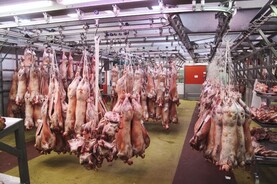Artificially rearing lambs
There are differing reports from farmers regarding the number of lambs that are being required to be transferred on to artificial rearing systems this season.
Some flocks recorded a lower scanning rate and as such had fewer triplet and quad litters but in contrast some flocks are reporting a higher percentage of ewes in poor body condition and having issues with rearing lambs.
Whichever the case, the aim with lambs reared artificially is to achieve high levels of performance while keeping costs in check. The latter can be best achieved by taking steps to limit the volume of milk replacer fed, including timely weaning.
Reducing the temperature of milk offered to lambs will reduce intake. The advice is to reduce from 28°C to 30°C back to 18°C to 20°C after 10 days and a further reduction then back to the environmental temperature (cold water from a tap).
The result of moving lambs to cold milk is that it will encourage lambs to eat higher quantities of concentrates and in turn limit milk intake to in the region of 400g daily over the final two weeks pre-weaning.
If lambs are left consuming warm milk, milk intake can be as high as 550g to 600g daily.
Weaning should ideally take place at around five weeks of age. This is governed by concentrate intake and for successful weaning lambs must be consuming at least 250g daily on three consecutive days and also weigh at least 9kg liveweight. Otherwise weaning will need to be delayed.
Fresh water is critical while offering a source of straw or good-quality hay / silage will help rumen development.
Selling cull ewes
The trade for cull ewes has moved on considerably in recent weeks with live sales igniting. Price quotes have also lifted considerably in factories but they are still not at a level capable of returning prices paid in live sales.
This is especially true for heavy carcase ewes with the carcase weight cut-off limit ranging from 40kg to 46kg, another factor that needs to be considered.
It is also advisable where presenting ewes live, to market them in a manner that will generate the most competition. For example there is little point in batching well-fleshed heavy ewes with lighter ewes lacking flesh while it is also good to batch ewes on type.
Marketing lambs
Next week is a big week for spring lamb sales in advance of the Easter market. Just is the case with cull ewes, it is advisable to weigh up market outlets and to select the route that will deliver the best return for the type of lambs on hand.
Demand is likely to be boosted by tight hogget supplies. Where lambs are likely to slaughter in excess of 20kg carcase weight then the best outlet may be the live trade where butchers are active.
Quick intervention
There are reports of health issues such as E.coli scour, joint ill and mastitis hitting in higher frequency in some flocks. This is not surprising given the challenging conditions.
The best hope of getting on top of an outbreak of scour or issues with joint ill is swift veterinary intervention. While oral antibiotic treatments are no longer on the market in Ireland vets can prescribe treatments which may help.
Hygiene and colostrum is critical. Veterinary intervention in the case of mastitis is valuable to ascertain the strain of mastitis.






 This is a subscriber-only article
This is a subscriber-only article










SHARING OPTIONS: